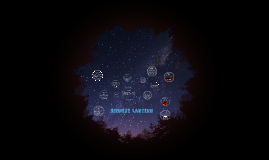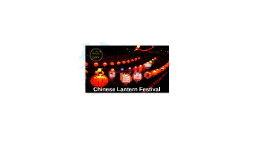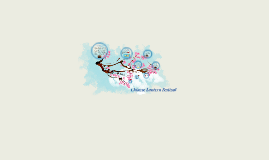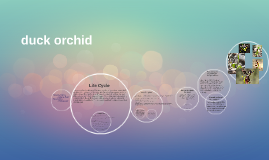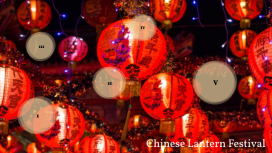Chinese Lantern
Transcript: history(continued) #3 Introduction history THE BEST PLACES TO GO ARE BEIJING, HONGKONG, AND NANJING, WHERE LANTERNS CAN BE SEEN EVERYWHERE! history (continued) Sorces -chINA HIGHLIGHTS (website) -chinese lanterns (article) - october 25 (date found) www.chinahighlights.com (url) uses for lanterns: then CONCLUSION #2 history (continued) #2 hanging on doors and gateways. it also underwent extensive design examination: lamp-shade artisans competed amongst themselves to produce lamp shades of exquisite beauty, punctionality, design, and artistic deciration. just as in the carnival of rio de janeiro, where contestants compete each year to create the most impressive costume, participants -> conclusion chinese red lanterns have A LONG HISTORY, AND THEY HAVE BECOME A WELL-KNOWN SYMBOL OF CHINA TOWNS WORLDWIDE. uses for lanterns: today #2 uses for lanterns: then #2 fEATURES in conclusion, the chinese lantern is a very historical tradition in chinese history, and the tradition is still alive today! but ya' know, there's A SECRET ABOUT CHINESE LANTERNS, BUT YOU HAVE TO PROMISE NOT TO TELL! Chinese Lantern uses for lanterns: then #3 chinese new year, mid-autumn festival, and lantern festival. in the ancient lantern festivals competed each year in creating or producing the most impressive lantern. the difference is that the best lantern in china-except for those reserved for the imperial palace-became public property: they were copied by every lamp-shade artisan throughout the country. the emperor himself had the best lamp-shade artisans in the empire work for him; such recognition was naturally the supreme honor. compounds, typical of beiging, but also seen elsewhere in china. it was also quickly dicovered that the lantern made an excellent "flashlight", or portable light. some historical experts believe thaT THE CONCEPT OF STREET LIGHTING IN EUROPE STEMS FROM EUROPEAN CONTACT WITH IMPERIAL CHINA, WHERE "STREET LIGHTING" HAD LONG EXISTED IN THE FORM OF THE CHINESE LANTERNS -> uses for lanterns: today although there is no longer a practical need for chinese lanterns, they are still made, used, and enjoyed by the chinese people. the streets both in big cities and small towns are decorated with red lanterns during festivals, especially THE MOST COMMON CHINESE LAnterns are red, have an oval shape, and decorated with red or gold tessels, but they come in many shapes; one style is square shaped. the materials for making a lantern vary: bamboo, wood, rattan, or steel wire for the frame; paper or silk for the shade; and FOR A LITTLE PIZAZ (JAZZ HANDS), PAINTING, PAPER CUTTING, AND EMBROIDery. the chinese lantern origanted as an improvemnet for the open flame. the shade not only protects the flame inside from being extinguished in windy weather, but it a also provides a more diffuse form of lighting. it was inevetible that the lantern shade would become the object of artistic expression, given the chinese penchant or embellishment. while the earliest chinese lanterns were created for practical use in the house and as entrance-way lighting, they eventually become highly ornamental, and as a status symbol. this is evident from how the red lanterns are extensively used in qiao family's compound, built in the qing dynasty, as well as at the gates to the siheyuan






